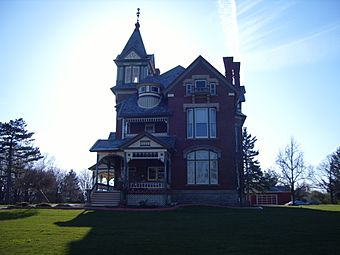Charles H. Bigelow House facts for kids
Quick facts for kids |
|
|
Charles H. Bigelow House
|
|

Front of the house
|
|
| Location | 2816 N. Main St., Findlay, Ohio |
|---|---|
| Area | 1.3 acres (0.53 ha) |
| Built | 1888 |
| Architect | Henry Oswald Wurmser |
| Architectural style | Queen Anne, Stick/Eastlake |
| NRHP reference No. | 06000200 |
| Added to NRHP | March 29, 2006 |
The Charles H. Bigelow House is a really old and special building in Findlay, Ohio, United States. It was added to the National Register of Historic Places on March 29, 2006. This means it's an important historical place that should be protected. The house is a great example of a "Painted Lady." This is a fun name for a Victorian house that uses many bright colors to show off its cool designs.
A Special House in Findlay
This amazing house was built between 1888 and 1889. This was a time when the town of Findlay was growing very fast. The house is about 7,500 square feet (700 m2) in size. It was designed by an architect named Henry Oswald Wurmser. He used a style called Queen Anne, Stick/Eastlake. This style is known for its fancy details and towers.
Built During a Boom
The owner of the house was Charles Henry Bigelow. His father was an early settler and a leader in the community. Charles followed in his father's footsteps. He became a very successful farmer and business leader. Many people in Findlay became rich during the late 1800s. This was because natural gas was discovered nearby. This discovery led to a big economic boom in the area. Charles Bigelow was one of the people who benefited from this exciting time. He later married May Vance, whose family was related to a former Ohio governor.
Inside the House
The house was built during Findlay's natural gas boom. Because of this, it has many original features that used gas. It first had seven gas fireplaces. It also had many gas lamps. One cool feature was an oriental brass light on the newel post (the main post at the bottom of a staircase). This light was shaped like a dragon. It looked like it breathed fire when the gas was lit! Today, all the gas features have been changed. The fireplaces now burn wood, and the lamps use electricity. In 1989, the outside of the house was carefully fixed up and repainted. They used colors like cream, red, and different greens. These colors help show off the beautiful wooden parts of the house.
A Famous House
The Charles H. Bigelow House has even been featured in books and on TV! In 1992, it appeared in a book called America's Painted Ladies. This book showed off many amazing, colorful Victorian homes. Later, in 1995, the house was part of a TV show. It was on David Copperfield's The Magic of David Copperfield XVI: Unexplained Forces. For the show, the house was called the "Barclay House." Its real history was changed for the story.



